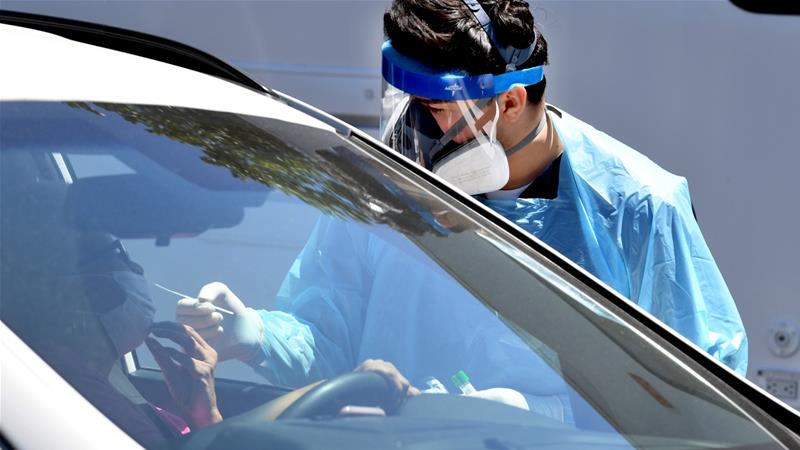
Doctor's Note: Does a high viral load make coronavirus worse?
A high prevalence of particles makes patients more infectious, but it is unclear if it leads to a more severe infection.
by Dr Sara KayatAccording to a study from the Royal College of Physicians in the United Kingdom, one-fifth of hospital doctors are off work sick or in quarantine due to COVID-19.
Even more concerning are the hundreds of healthcare professionals that have died from COVID-19, with the toll reaching at least 630 according to Medscape.
One of the theories as to why many otherwise healthy front-line healthcare workers are dying from the coronavirus is that they are exposed to higher amounts of COVID-19 particles while treating patients.
This is known as the viral load, which is the number of viral particles carried by an infected person that they then shed into their environment.
Doctors have to get very close to patients in order to carry out procedures like taking samples from them or performing intubation and extubation (putting in and taking out breathing tubes), so it is assumed that more viral particles will be transferred to them.
Viral load and severity: An inconclusive link
If you have a high viral load you are more likely to infect other people, but questions are also being asked about whether a high viral load could make your outcome from a COVID-19 infection worse.
With infections like the middle eastern respiratory syndrome (MERS) and severe acute respiratory syndrome (SARS), which are coronaviruses that share some similarities to COVID-19, there is a correlation.
In the 2002-2003 SARS outbreak, it was found that patients with higher initial viral loads had worse outcomes, and it was suggested that viral load should be taken into consideration in addition to age and comorbidities when predicting the prognosis of patients infected with SARS.
There was also a similar finding in influenza studies. In one study, healthy participants were given escalating doses (known as a human challenge) of influenza type A, and it was documented that the number and severity of symptoms correlated well with viral load.
However, with COVID-19 the results thus far have been less conclusive.
In a review of 5,000 patients in Italy, they did not find a difference in the viral loads of patients with symptoms and those without symptoms, which implies that viral load does not determine severity.
In another study of 94 patients from China, they found that patients with COVID-19 shed (or released) the virus the most at initial onset, or before symptoms became apparent, and that a substantial proportion of transmission likely occurred before the first symptoms even appeared. This again may suggest that the viral load does not necessarily correlate with how severe the symptoms are.
However, conversely, another China study of 76 patients showed that those with severe COVID-19 did indeed have a high viral load, and even found them to shed the virus for longer, which would suggest that viral load is a marker for severity.
For the time being, it will be very difficult for us to know definitively whether viral load is associated with severity in COVID-19, as a human challenge study like that done with influenza A would need to be carried out, whereby you infect healthy individuals with incremental amounts of the virus and then assess the severity of their symptoms. However, this would be unethical given how severe this infection can be in some people.
Why are front line medical staff falling ill?
With the mixed results coming from these preliminary studies, it is still important to look into other possible causes as to why a higher proportion of front line staff are falling ill with COVID-19.
Some have suggested that sleep deprivation may be an element.
Evidence supports the need to sleep for seven to eight hours each night and suggests that those who regularly sleep less than this are at higher risk of serious health problems such as heart disease, diabetes and stroke.
In terms of infections, we know from studying the rhinovirus (the common cold), that those who slept fewer than five hours a night were significantly more likely to develop a cold than those who slept seven or more hours.
It may, therefore, be that the sleep-shy healthcare professionals on the front line, are more susceptible to the effects of COVID-19 than their well-rested counterparts.
There is also likely to be a genetic susceptibility, making certain individuals more vulnerable to the virus. While this would not account for why healthcare professionals specifically may be at higher risk, it would explain why some of the young, fit and healthy population (which generally includes healthcare professionals) are being unexpectedly affected.
There are examples of this type of genetic susceptibility with numerous other infections. One example is that of the herpes simplex virus. For many, this virus just causes cold sores, which are annoying but not life-threatening. However, in 1/10,000 infected with this virus, it results in a disease called herpes simplex encephalitis, which can cause seizures and even be fatal if left untreated, and is thought to be caused by a genetic mutation which renders the patient far more vulnerable to this virus.
In light of all these uncertainties, it is still essential for the population - including healthcare workers - to minimise exposure to the virus as much as possible, by wearing as much protective equipment as is available, by practising social distancing, and by observing strict hand hygiene.